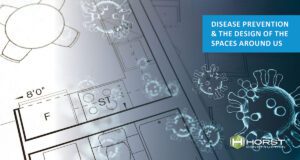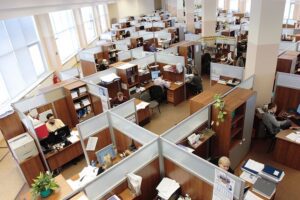Disease Prevention & the Design of the Spaces Around Us

The shifts we expect to see in design trends, as informed by the COVID-19 pandemic
There is no doubt that the COVID-19 pandemic that has clutched the entire world in its grasp for months will have a large impact on the way the public spaces we are accustomed to are designed.
If one thing is for sure, it’s that the current situation has provided us all with a new perspective and reminded us of how important it is to be mindful of how sanitary (or unsanitary) many public places are.
In this article, we have compiled a list of design trend shifts we expect to see as we begin to piece together a plan to return to a new normal. In light of recent events, we anticipate regulatory requirements that will protect the public as well as employees.
However, we also acknowledge that many savvy business owners will be looking for ways to proactively prepare in ways that make their organizations safer for employees and those they serve. By taking steps to provide peace of mind, these owners are setting themselves up for a more successful return.
Here are a few ways you may be able to create a public space that’s a little safer:
- Install Sanitizing & Cleaning Stations
- Embrace Touchless Technology
- Clear the Air
- The End of the Open Office?
- Make Gatherings Safer
- Cautiously Implement Antimicrobial Materials
1. Install Sanitizing & Cleaning Stations
 Our hands come into contact with thousands of items each day that harbor germs. When we touch things like buttons, door handles, or railings, we risk infecting ourselves, and we risk spreading those germs to other high-touch items.
Our hands come into contact with thousands of items each day that harbor germs. When we touch things like buttons, door handles, or railings, we risk infecting ourselves, and we risk spreading those germs to other high-touch items.
One of the easiest ways we can reduce the spread of germs is with frequent hand washing. That’s why we may see an increase in sinks, handwashing stations, and sanitizing stations in our buildings and public spaces.
These can go beyond places we’re used to, like kitchens and bathrooms. They can be installed in lobbies where people often meet and shake hands, near concession stands and registers, or at the entrance and exit of your building. By creating more of these spaces in high-traffic areas, you can give a subtle reminder to your building’s occupants to frequently wash their hands.
The easier you make doing it, the more they will do so.
2. Embrace Touchless Technology
Touchless technology has been around in various forms for a few decades, but post-quarantine life will likely give its application a boost. By replacing high-touch surfaces like door handles, elevator buttons, and light switches with touchless tech, you’ll be eliminating areas for germs to converge and spread.
Replace your doors with ones that open automatically when someone is near, or eliminate the doors all together if they’re not necessary. As we’ve already seen in many public spaces, with a subtle change in design, even the doors to public restroom entrances can be eliminated.
If security is a major concern, replace keypads with key-swipe locks. Install motion-sensing lighting to eliminate the need to touch a light switch each time you go in and out of a room. This one may also save you money on energy costs, too!
Keep an eye out for new voice-operated technologies as well. With smart speakers and voice search on the rise, we’ll surely see these technologies applied to buildings to help reduce the spread of germs.
3. Clear the Air
An illness that can be transmitted via air is an unsettling thought. If someone coughs in their office, can they infect someone a few offices down the line through recirculated air? As experts debate the answer to this question[1], there are a few things you may be able to do to prevent the potential spread of germs through your HVAC.
One way you could potentially clean the air is through air filters and purifiers. HEPA filters can catch small particles just 0.3 microns in size, which would include a variety of bacteria (bacteria ranges from 0.2 – 10 microns). However, viruses (like COVID-19) are much smaller than bacteria and may be able to pass through the HEPA filter[2]. Some HEPA filters are made with silver – an anti-fungal, anti-virus, and anti-bacterial material, which may help prevent the growth and spread of even the very small illness-causing germs.
Other air purification methods are ultraviolet light purifiers and heat sterilization purifiers. These methods rely on the cleansing power of light or extreme heat to kill off germs in the air as they travel through the filter and may be more effective at getting rid of smaller, virus-sized germs.
Additionally, keeping windows open to increase airflow could help limit the dirty air spreading throughout the building.
4. The End of the Open Office?
 While open offices can help promote a sense of togetherness and make collaborating easier, many have called into question their effectiveness and their impact on productivity. While that’s still up for debate, one thing is for sure – they make social distancing at work more difficult.
While open offices can help promote a sense of togetherness and make collaborating easier, many have called into question their effectiveness and their impact on productivity. While that’s still up for debate, one thing is for sure – they make social distancing at work more difficult.
As there’s now a strong case for workplaces that are more private, we may see businesses gravitating back towards office-based or cubicle-based environments. Whether that’s revamping your entire office space to make separate rooms, or installing partitions between desks, physical barriers between offices could help slow the spread of germs.
5. Make Gatherings Safe
Humans are social creatures, and our desire to gather in groups and socialize shouldn’t completely end. The spaces in which we do them, however, should adjust in ways that keep everyone safe.
We may start seeing a shift to larger, more open spaces that make it easier to spread out and maintain the appropriate distance between people. Barriers between restaurant and café tables, and between cashiers and customers in check out lines may become the new norm as we transition from total in-home isolation to protective measures in public that make interaction possible and safe.
Countertops, furniture, and other surfaces may be replaced with materials that are easier to clean, less porous, and less likely to harbor germs.
6. Cautiously Implement Antimicrobial Materials
 Before we explain this point further, we just want to say the microbial world is an extremely complex and important one. While there are plenty of harmful viruses and bacteria that we’d love to be rid of, there are also a lot of helpful germs that we need in order to survive. Antimicrobial materials should be used sparingly and with the utmost care to maintain the natural balance of our ecosystem[3].
Before we explain this point further, we just want to say the microbial world is an extremely complex and important one. While there are plenty of harmful viruses and bacteria that we’d love to be rid of, there are also a lot of helpful germs that we need in order to survive. Antimicrobial materials should be used sparingly and with the utmost care to maintain the natural balance of our ecosystem[3].
That said, the careful use of some microbial finishes may be able to help prevent the spread of harmful germs around your building. Materials like copper and bronze are naturally germ-killing and can be used on high-touch surfaces or areas where germs can sit, like countertops[4].
The overuse of such materials, however, could lead to the acceleration of microbes’ evolution, creating germs that are immune to the anti-microbial effects. Keep this in mind when implementing any type of antimicrobial finishes, be them naturally occurring metals or synthetically developed coatings.
Keep Doing Our Best
In the face of the new challenges COVID-19 has brought to nearly every facet of our lives, it’s important to focus on what we’re able to control and take pertinent precautions to keep everyone safe. Be sure to continue following all guidelines and regulations for your area and your industry.
We’ll pull through and come out of this stronger than before.
[1] https://www.businessinsider.com/turning-off-ac-could-limit-chance-of-infection-experts-say-2020-4
[2] https://homeairguides.com/reviews/best-air-purifier-for-bacteria-and-viruses-and-germs/
[3] https://www.bdcnetwork.com/perkinswill-white-paper-antimicrobial-building-products-should-be-avoided-whenever-possible
[4] https://www.ncbi.nlm.nih.gov/pmc/articles/PMC5609261/
Posted May 27, 2020

